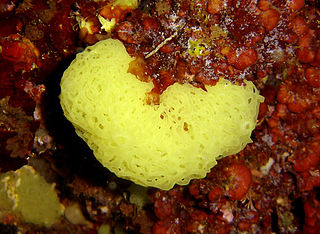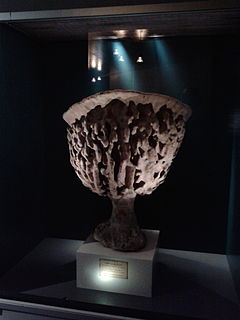
The Clathrinida are an order of calcareous sponges found in marine environments. These sponges have an asconoid structure and lack a true dermal membrane or cortex. The spongocoel is lined with choanocytes.

Clathrina is a genus of calcareous sponge in the family Clathrinidae. Several species formerly in Clathrina were transferred to the newly erected genera Arturia, Ernstia, Borojevia, and Brattegardia in 2013. The name is derived from the Latin word "clathratus" meaning "latticed".

Halichondriidae is a family of sea sponges belonging to the order Suberitida. These sponges have a skeleton consisting of dense bundles of spicules occurring in a more or less random pattern.

Halichondria is a genus of sea sponges belonging to the family Halichondriidae. These are massive, amorphous sponges with clearly separated inner and outer skeletons consisting of bundles of spicules arranged in a seemingly random pattern.

Halichondria panicea, commonly known as the breadcrumb sponge, is a species of sea sponge belonging to the family Halichondriidae. This is an abundant sponge of coastal areas of the North Atlantic and the Mediterranean Sea ranging from the intertidal zone to a recorded depth of over 550 m. It is also found in the intertidal zone of the coast of the northern part of the North Island of New Zealand. It is very tolerant of a wide range of coastal habitats, including strong currents, high salinity and exposure to powerful wave action. Its only requirement is a rocky substrate which can include small cobbles.

Agelas clathrodes, also known as the orange elephant ear sponge, is a species of sea sponge. It lives on reefs in the Caribbean, usually more than 10 metres (33 ft) below the surface of the ocean. It takes various forms, and its color is reddish orange.

Tetillidae is a family of marine sponges. Tetillids are more or less spherical sponges which are found commonly in all marine habitats at all depths throughout the world. They are especially common in sedimented habitats. Over a hundred species have been described in ten genera.

Homosclerophorida is an order of marine sponges. It is the only order in the monotypic class Homoscleromorpha. The order is composed of two families: Plakinidae and Oscarellidae.
Ascandra izuensis is a species of ssea sponge in the family Clathrinidae. The species is named after the Izu peninsula where the holotype was collected.
Pseudospongosorites is a genus of sea sponges belonging to the family Suberitidae. Currently, the genus is considered as monotypic, consisting of a single species Pseudospongosorites suberitoides. It is found in the Caribbean Sea, the Gulf of Mexico and on the Atlantic coast of the United States as far north as North Carolina. This species is known by the common name Florida hermit crab sponge, so named because hermit crabs often use it as shelter.

Rhabdastrella globostellata, also known as the yellow pot sponge, is a marine sponge of the order Astrophorida. It is native to many regions of the Indian Ocean including the shores of Madagascar, the Seychelles, and Australia as well as the Malayan Peninsula and Singapore. It was first described by Henry J. Carter as Stelleta globostellata in 1883, named after the globostellate shape of its spicules.

Cliona patera, commonly called Neptune's cup sponge, is a species of demosponge in the family Clionaidae.
Aplysina insularis, commonly known as the yellow-green candle sponge or yellow candle sponge, is a species of sea sponge found on reefs in the Caribbean Sea and the Gulf of Mexico.

Dictyoceratida is an order of sponges in the subclass Ceractinomorpha containing five families. Along with the Dendroceratida, it is one of the two orders of demosponges that make up the keratose or "horny" sponges, in which a mineral skeleton is minimal or absent and a skeleton of organic fibers containing spongin, a collagen-like material, is present instead.
Neopetrosia subtriangularis is a species of marine petrosiid sponges native to the waters off Florida and the Caribbean Sea. They superficially resemble staghorn corals.
Agelas tubulata is a species of demosponge. It is tube-shaped or vase-shaped and variable in colour. It is found in the Caribbean area and along the coasts of Brazil at depths of between about 70 and 90 m. It was first described by Lehnert & van Soest in 1996, the type location being the Greater Antilles.
Spongillida is an order of sea sponges in the subclass Heteroscleromorpha.










